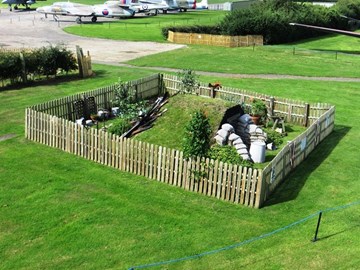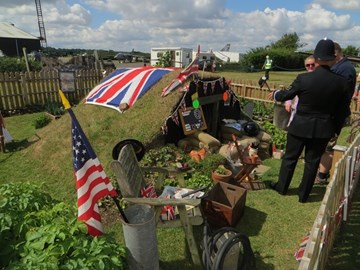

Back in 2012 the museum was honoured to be included in an education programme that was developed in-conjunction with Aviation Heritage Lincolnshire (AHL) and the Arts Council England (ACE).
As part of this programme we received grants from AHL to support and enhance our programme of education activities. One item that was completed in 2014 was an Anderson Shelter, which is used for the World War II / Evacuation topic.
Rather than secure an old Anderson Shelter structure the museum utilised the grant funding to purchase a new unit. Research showed that many Anderson Shelters on display were not installed in authentic conditions, so we decided to change this.
Delivered in kit form it was assembled in Hangar 1 by staff member Nigel Bean and volunteer Bill Potter. The site excavation / installation work for the project was undertaken by local contractor; the Anderson Shelter was lifted into position; it was then covered with the excavated soil and turfed over.
To add authenticity to the Anderson Shelter, it was ‘furnished’ with representative ‘period-style’ bunk beds and associated fixtures and fittings. With significant visitor interest being generated and grant funds still available it was decided to expand the project into a mini-tableaux of World War II local life.
This work has been undertaken by Nigel Bean and his wife Jude and was achieved by fencing an area off around the shelter and adding a ‘Dig For Victory’ vegetable plot. Their enthusiasm and dedication to the project has reaped many benefits and literally brought it to life as a ‘living history project’.
Previously stored objects like a period RAF bicycle have been incorporated into the tableaux, with its position changing each day. While nearby a UXB bomb is carefully being disarmed & recovered from a trench in the top of the drainage dyke bank. ‘Walk very carefully if going to inspect this exhibit!’
The Victory Garden is used for visiting school groups but it also engages with the older visitors who love to recount their own experiences of life in wartime and post-war Anderson Shelters.
Don't forget to keep a watch for our #NAMVictoryGarden hash-tag on Twitter!
Anderson Shelter Facts
The Anderson shelter was designed in 1938 by an engineer called William Patterson & named after Sir John Anderson, who was responsible for preparing Britain for German air raids.
Anderson shelters were free to those with an annual income of less than £250. For those who didn’t fall into this category, the price was £7.
It’s estimated that around 3.5 million Anderson shelters were eventually built and they were effective at saving lives and preventing major injuries during air raids, but they were really cold & damp, especially in the winter months.